1967 South African Grand Prix race report: Heartbreak for Love
John Love and his local support are left devastated as an unlikely win falls victim to fuel issues, handing a debut win to Pedro Rodriguez
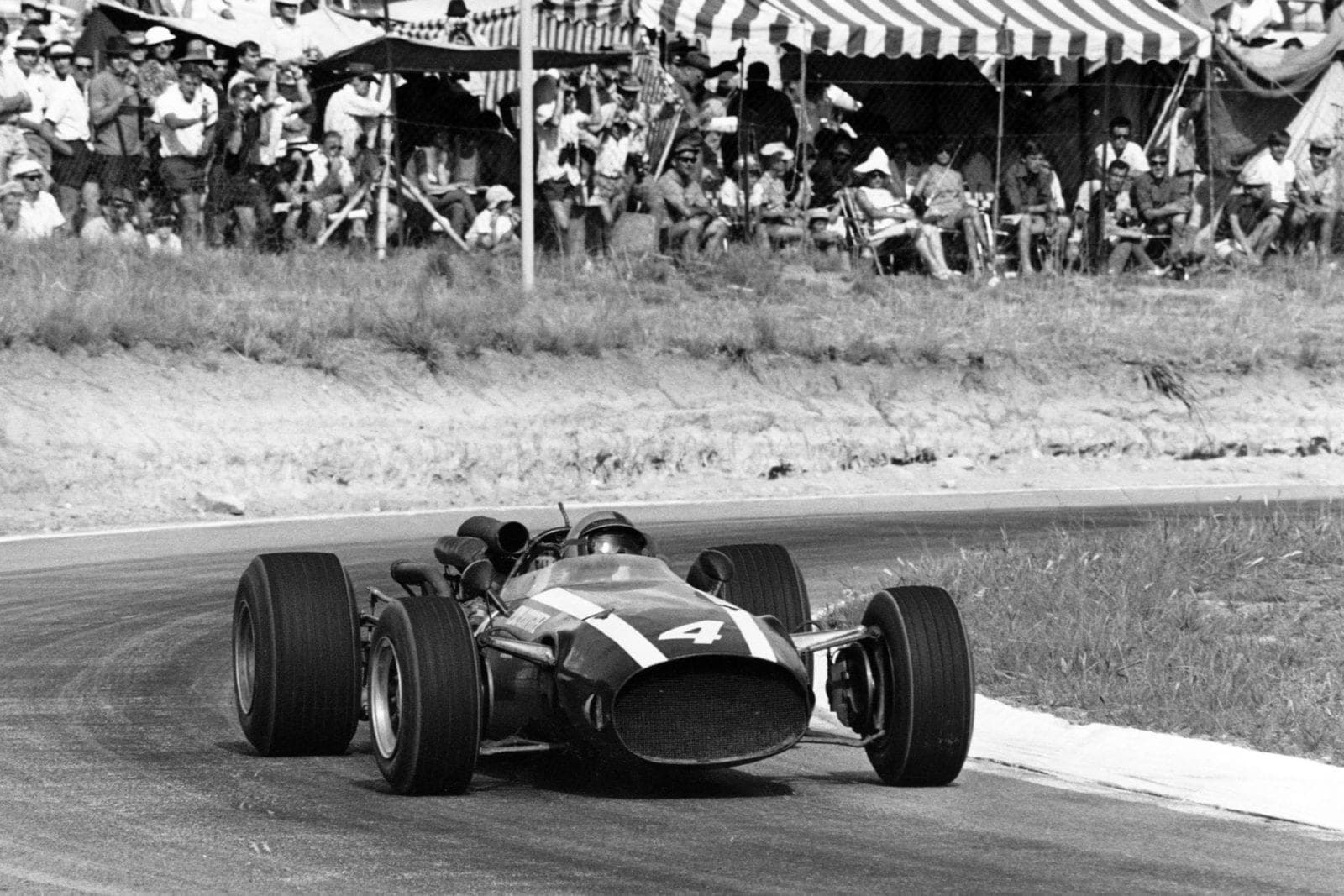
Pedro Rodriguez benefitted from Love's misfortune to take his first win, driving for Cooper
Motorsport Images
Three previous South African Grands Prix have been of world championship status at the coastal resort of East London. However, after the 1966 race being a non-championship event the venue has been moved to the 2.5-mile circuit at Kyalami, just outside Johannesburg. The circuit is narrow, but interesting, the corners being varied and tricky, with a reasonable straight and fair pits. One disadvantage of this circuit is that it is 5,000 feet above sea level and when the weather is hot all the atmospheric and fuel vaporising problems arise. The lap speed stood at just over 100mph and was held by John Love’s Cooper-Climax 2.7.
All the major GP teams had accepted entries with the exception of Ferrari who could not get cars ready in time due to the racing department being rebuilt.
The Brabham team had two cars for Brabham and Hulme. These were unaltered since Mexico and were in their usual well-prepared state. Coopers had brought two cars for Rindt and Rodriguez. Both had the wide-angled inlet trumpets and had Magneti Marelli coil ignition. The car driven by Rodriguez was the one used in Mexico by Surtees, and in a pre-practice run the Mexican settled in very quickly except for vaporisation which slowed him after every few laps.
* * *
Two new sixteen-cylinder BRMs were here for Stewart, now the No 1 driver, and for Mike Spence who has joined the team for 1967. Since Mexico BRM have had several test sessions to improve handling and engine reliability. Most of the changes are only detail but two noticeable ones are the air scoops taking air to the centre of the ventilated discs which were first used without scoops at Watkins Glen, and the rear lower wishbones which have been filled in to strengthen them. Three different noses had been brought, the usual one used for most of last year, a very short one which was cut off flush with the radiator and a new wind tunnel designed nose with a number of slit vents behind the radiator line.
Team Lotus had two H16 BRM Lotus 43s, both using the older “double-eight ” engines, a new chassis R43/2 for Clark and the older chassis R43/1 for Graham Hill. Both cars were the same and there had been no further development as this was expected to be the last race in which Lotus will use the H16 BRM engine, their own Cosworth V8 being scheduled for the beginning of the European season.
John Surtees was entered by Honda Racing and Development Co Ltd in last year’s car using the wide suspension. Some minor changes had been made to the suspension geometry to improve handling and get over the bump steer they were suffering during the last three races of 1966. Surtees was working very hard to get the red and white car sorted before practice began and had two days of unofficial testing to get the fuel mix right and the car set up. Unfortunately for him some foreign matter in the BP oil caused considerable internal damage to the engine. When the spare engine was fitted to be ready for first practice, it too was damaged by foreign matter in the oil, so while the other cars practised on the first day the Honda mechanics and Surtees were stripping both engines and rebuilding one from the bits.
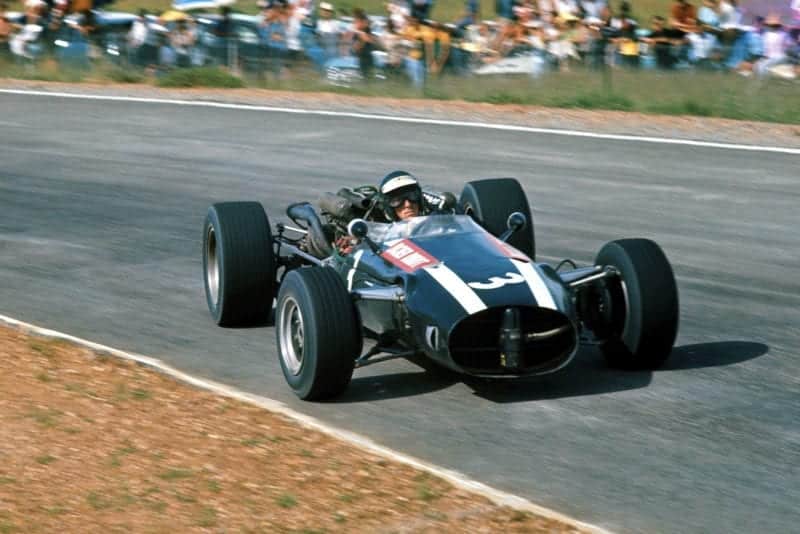
Rindt shows full commitment in his Cooper
Motorsport Images
The Eagle made up the recognised team entries. Of the two cars entered for Gurney and Ginther only one turned up. This was the 2.7 Climax car which has been run all year. The new V12s are still not right although during testing the problems are being successfully overcome. The 2.7 Climax engine is not affected by altitude as much as the multi-cylinder units, and it was hoped that Gurney would stand a very good chance against the more sophisticated machinery.
The private owners made up the further eight entries. Siffert was entered in the Walker-Durlacher Cooper-Maserati, which had boxed-in air intakes similar to those Surtees had last year. Bonnier had his own Cooper-Maserati exactly the same as previously raced. Bob Anderson had his own Brabham-Climax 2.7-litre which he painted pale blue with a white stripe.
Piers Courage was down to drive the Parnell Lotus-BRM V8. This was his first Grand Prix drive and he and Chris Irwin will be driving Parnell-BRMs in 1967. The last four drivers were all locals from Southern Africa, John Love with his very fast Cooper Climax 2.7, Sam Tingle in an LDS Climax 2.7-litre, Dave Charlton and Luki Botha, both with Brabham-Climax 2.7s, the former with a 1964 chassis and the latter a 1963 chassis.
Qualifying
Practice was from 2:30pm until 5pm on the Thursday, Friday and Saturday before the race on Monday. Also, cars could practise any morning but there would be no marshals or timing. Thursday’s practice was cool by local standards, the temperature being in the 70s, but only ten cars turned up. The Honda team were rebuilding their engine, Hill’s Lotus developed a leaking petrol bag which kept it back at the garage and the other competitors felt that two days’ practice would be sufficient so missed the first day.
Stewart went out first followed by Rindt. Stewart did a few laps then came in with his tyres decidedly worse for wear. Lumps had been torn out and gashes had appeared down the middle of the tread. No one connected with the team was particularly perturbed as this was expected, for the tyres are a new Dunlop rain compound and Tony Rudd wanted to know how many laps they would last after the circuit dried out, and the answer was between five and ten laps. Stewart then transferred to Spence’s car to see whether it was set up properly, and he put in several laps on Goodyear tyres. Both cars were having over-heating problems and the new wind tunnel nose was taken off to be replaced by the flush-with-radiator nose.
Coopers were not having a very good time, both cars overheating and boiling the fuel. Of the two, Rodriguez was going slightly better and he got second fastest time with a lap of 1min 29.4sec before misfiring brought him to the pits. Rindt, on the other hand, didn’t manage to complete one lap with the engine running cleanly and this kept him three seconds slower.
Gurney had only two spells while the car was being sorted out. However, after his second spell, when he clocked 1min 32.4sec, a plug was removed; a spectator who had got into the pits leaned on the rear wheel and a stone in the tread popped out, landed on the engine and slid into the plughole. After fishing for some time without success the engine was started on three plugs and the stone came out as dust. When practice finished, the Eagle put in a few more untimed laps at about 1min 30sec.
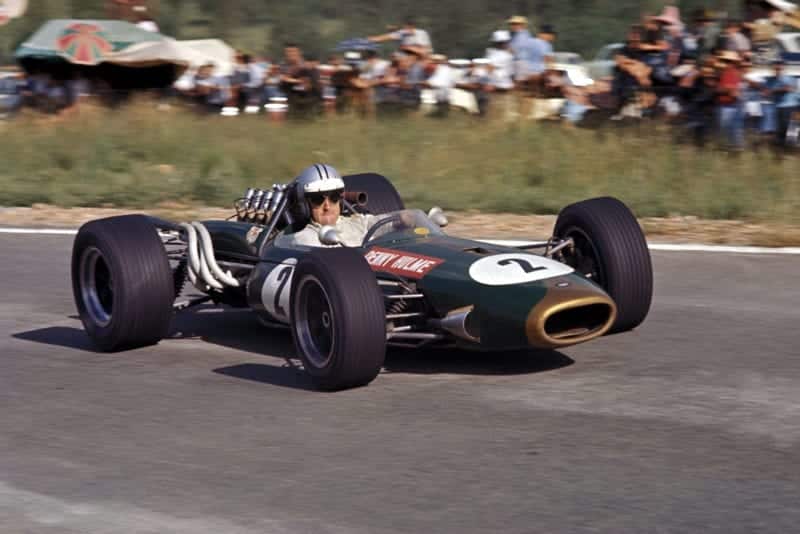
The cars of Hulme (above) and Jack Brabham seemed to be handling overheating issues better than most
Motorsport Images
The Brabhams seemed to be the only team not having overheating problems and Jack held fastest time for most of the afternoon, finishing with a time of 1min 28.3sec, 166.913kph. HuIme was not quite so quick, just over two seconds behind. In his usual way. Brabham’s fast lap was done just as practice was finishing. Charlton and Anderson both practised but their times were well down.
Jim Clark was having problems connected with driving a new car for the first time and was not very quick. In the latter stages of practice Spence went out and seemed to settle down quite quickly, while Stewart, who was trying three makes of tyre, coasted in very slowly twenty minutes from the end of practice with a blown-up engine. A liner had shattered and steam was pouring from the crankcase breather and from the top right rear air intake. This blow-up stopped tyre testing until next day with no results for Firestone.
On the Friday the sky was clear, the wind nil and the result a very hot practice session. One of the tyre experts took air readings of 90deg F and track temperature of 140deg F, with all tyres running 12deg F hotter. More cars were practising although Brabham took the afternoon off, rather than wear out his car. Sam Tingle still didn’t turn up although his car was in town, while Rodriguez’ car was having its gearbox changed and Stewart took over Spence’s car. His own car was still minus an engine, the spare engine not being freed from Customs until late morning.
Hulme put in a lot of laps, suffering less from heat than most cars, and he finally just got down into the 28’s, the only driver other than Love to better 1min 30sec on this second practice session. Rindt did a lot of laps, trying to get over the heating problems and finally did a 1min 30.2sec lap although the Cooper still did not sound right. The Lotus team were still sorting out problems and Clark improved by two seconds, while Hill only completed five laps, his car over-heating badly.
Stewart continued tyre testing, finally deciding the Dunlops were two-tenths faster, which settled the argument for this race. BRM’s over-heating problems were better, although Stewart’s radiator developed a leak before the end of practice. The two private Cooper-Maseratis were in real trouble, both suffering badly from vaporisation. The 2.7 Climax engines were giving the least trouble due to heat, Dave Charlton finishing with a time faster than Stewart, Clark, Hill and Gurney. The big surprise, however, was the speed John Love got his Cooper-Climax 2.7 round. He lapped at 1min 29.5sec, which gave him a second fastest time for the Friday practice.
Surtees was still in trouble. The rebuilt Honda engine was having vaporisation problems which kept the speed well down even though two fuel radiators were fitted, one on the side and one behind the driver’s head in the roll-bar. Surtees refused to take his car to the scrutineering bay as this meant wheeling it over a dusty, rough track and he did not want to get any more dirt in the engine. The paddock area was very rough and dusty and most cars kept well away.
Practice finished and a lot of work was going to have to be done by next day to try and cool everything down. The Honda team called for a special unofficial session at 7am on Saturday where they got well under 1min 30sec for a series of laps. Also, Surtees did tyre tests, finally finding Firestone half a second faster than Goodyear. As the day warmed up it again became very hot by early afternoon when practice was due to start, although a breeze made spectating less trying than Friday. Overnight Lotus had put the water pipes outside the monocoque to get a bit of extra cooling.
Sharp on 2:30pm the two Coopers were off to see if the vaporising problem had been overcome. Other than cutting the nose away, both engines had their mechanical fuel pumps reversed so the pump stuck out the back and, instead of mounting direct on to the engine, it was mounted onto a fibre ring which was in turn mounted onto the engine. A flexible air duct sent a flow of air over the pump and after a short time out it was obvious that the cure would last.
Graham Hill went out but was soon back in the pits after he spun at the Esses when his throttle stuck open, also he had a fuel leak which found its way on to his seat. When the throttle and fuel leak were rectified Hill went out again only to find that the engine would not run properly and the diaphragm in the metering unit had broken. This went again later and Graham only managed to do eight laps which, added to the five laps the previous day, made a total of thirteen, a figure very much lower than he would normally have liked to do.
Spence’s BRM was ready to go as practice started but Stewart’s car was being worked on “to stop their No 1 driver wearing himself out”. When the master cylinders had been changed, Stewart went out and after trying very hard, he got down to 1min 30.3sec. Some oil at the Esses caused Clark to spin, although whenever he really tried the tail of the Lotus was hung well out.
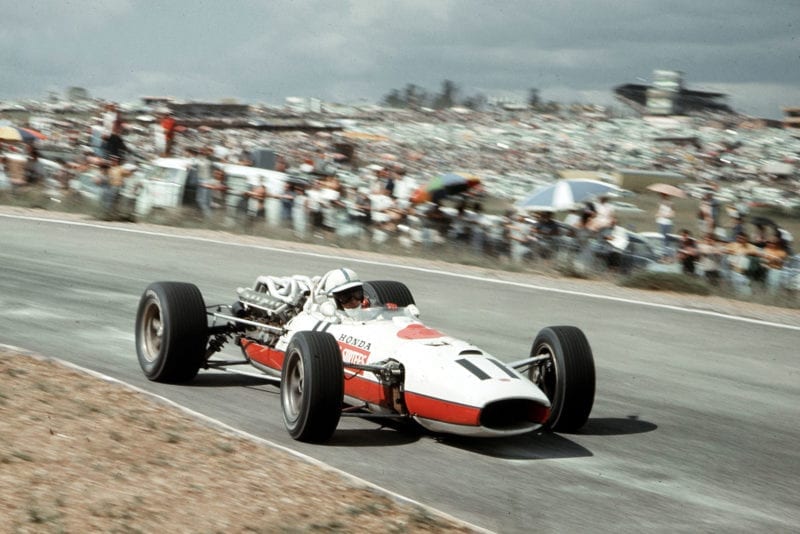
Surtees moved from Cooper to Honda for ’67
Motorsport Images
Brabham and Hulme were having trouble-free runs until Hulme stopped on the circuit when his fuel pump packed up. A mechanic was sent out and repairs made which allowed a few more laps before the flag went out. Both Brabhams were under 1min 30sec, with Jack setting the fastest time of the day at 1min 28.5sec.
Surtees arrived late, and put in a number of laps under 1min 30sec, but he was not really happy with the car, for it was still over-heating and the handling was not all that could he desired.
Sam Tingle turned up for this practice and put in a lot of laps to make up for the two missing days, and his time of 1min 32.4sec put him on the same line of the grid as Spence. Bonnier had got over his heating problems but Siffert was still in trouble with the engine cutting and sounding horrible. Piers Courage did not seem to get as much as he might out of the BRM V8 and was the slowest time on the grid.
John Love decided to conserve his car as he felt certain that he could not better his previous day’s time and he did not want to wear the car out. Practice finished on time but an extra untimed spell was allowed for Hill and Rindt, as they still needed to do some further laps. A lot of work was still needed to make sure the cars had a chance of finishing in the hot sun. Gurney decided to change his engine, as it seemed flat.
Other teams had a lot of preparation work to do. However, mechanics had all of Sunday to get the work done, while those not actually getting their hands dirty could either sun bathe by their hotel pool or go with Goodyear to the Kruger National Park and commune with Nature.
Race
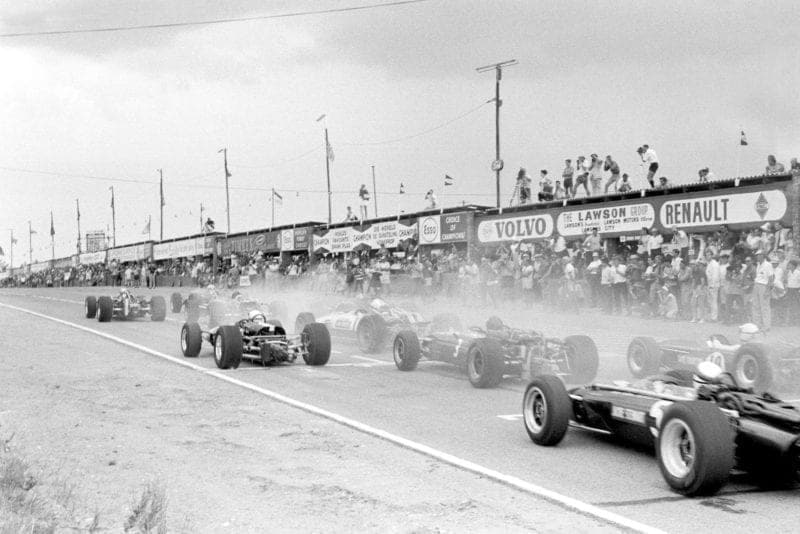
The race begins
Motorsport Images
On the night before the race a tropical thunderstorm washed the circuit clear of the rubber build-up of the last week. Under normal circumstances this would have been very acceptable but the Kyalami track is made of very sharp, abrasive materials and some of the tyres would not last 80 laps on a clean track. Very early a large crowd was parked all round the circuit and at 6:30am, Rindt put in some practice laps to see if Sunday’s tuning had squeezed the little extra power at the top end that Rodriguez was getting but it hadn’t. Unfortunately, the engine was still down on power and revs.
A half-hour’s practice between 11:30 and 12 had Honda changing back from Firestone to Goodyear due to over-revving now that the engine was going better and the Goodyears had slightly greater diameter than the Firestones. BRM had followed Lotus’ lead and had moved the water pipes outside the monocoque. Gurney was a bit quicker with the changed engine. Lotus had changed the complete metering unit on Hill’s car and it was certainly running better.
“Clark, who was nearly sandwiched by the two Brabhams, hesitated and Surtees shot by in the wake of Hulme and Brabham”
After some preliminary races and a parade of drivers in vintage machines, the cars did a warming-up lap and formed up on the dummy grid. At 3:10pm the flag dropped and at once Hulme leapt into the lead. Clark, who was nearly sandwiched by the two Brabhams, hesitated and Surtees shot by in the wake of Hulme and Brabham. On the line was Luki Botha; his engine had died and he lost a complete lap getting going again. As the cars streamed by at the end of lap one, Hulme was several cars’ lengths ahead of his team leader with Surtees right up with them. Then came Rodriguez, Clark, Rindt, Charlton, Stewart, Love, Anderson, Bonnier, Courage, Gurney, Siffert, Tingle, Spence and Hill with Botha almost a lap behind.
Visibility on the early laps was not very good, as over-enthusiasm by certain marshals to cover up oil had led to clouds of cement dust being blown up by the car in front, obliterating all except the front car’s view. On the next lap, Rindt went by Clark to get at his team-mate Rodriguez. Spence and Hill went ahead of Courage and Tingle, while Gurney picked up three places on the second lap. Stewart passed the pits on lap 2 in the same eighth place but he did not appear next lap, for his engine had blown up in a big way and the first of the multi-cylinder cars was out.
Rindt was no sooner right up on Rodriguez than he went by into third place behind the Honda, for Brabham had got sideways on at Crowthorne Corner and Surtees just touched him, putting the Australian back to fourth place between the Coopers. Rindt’s third place did not last long, for he was stretching the road-holding to the limit, and on lap 5 he dropped to sixth place after a spin.
Spence and Hill moved up two more places on the third lap, then the Lotus went by the BRM and for two laps these two diced for 12th place. Then, on the sixth lap, Hill went off at Crowthorne and when he regained the road, a front wishbone was bent and an oil-pipe had been torn off. As the Lotus limped back slowly to the pits a wide swathe of oil was laid on the road behind him, which gave rise to clouds more cement dust.
Hulme’s lead was by lap eight up to eight seconds over Surtees who had started to slow up a little in the Honda. For a few laps, the positions remained stable while Brabham, with Rodriguez and Rindt just behind slowly gained on the Honda. On lap 15 Brabham caught Surtees but was unable to get by and, after trying for a lap, Rodriguez slipped by Brabham so that he could have a go at the very wide Honda.
As the four cars came out of Clubhouse Corner the Mexican pulled up alongside the Honda and it looked as if he was past, but just before the braking point, the Cooper hesitated and the Honda remained in second place. On lap 19 both Brabham and Rindt were past Rodriguez and the Number Two Cooper driver was in trouble, for he could not get all his gears and it looked as if his race was run. However, he plodded on, always seeming to be in a gear either too high or too low.
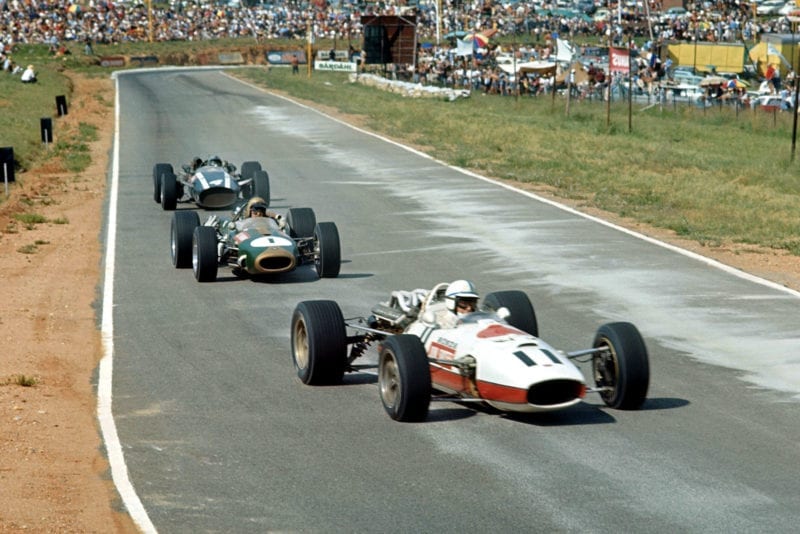
Surtees Brabham and Rordriguez leads early on
Motorsport Images
Surtees couldn’t hold Brabham back indefinitely and on lap 21 the Brabham team were once again first and second. Rindt was next to try and pass the Honda but he overdid it at Leeukop bend and again dropped back behind Rodriguez. This time he was much quicker regaining his lost place and on lap 23 he was by his team-mate and on the next lap he went by Surtees into third place.
While this place-swapping was going on the next casualty of the heat and altitude made a pit-stop. Clark had noticed the Lotus-BRM over-heating and came into the pits. The nose was removed and Clark did three more laps, which had no effect on the high temperatures. The Lotus retired on lap 22 with a broken diaphragm in the metering unit. This left only one H16 engine running.
“Love and Gurney were coming up through the field. This dice was keeping the crowd more on their toes than the leaders”
About the tenth lap two of the 2.7-litre Climax-engined cars had got together. Love and Gurney were coming up through the field from 10th to fifth. This dice between the Californian and the Rhodesian was keeping the crowd more on their toes than the leaders. Gurney made some efforts to get by Love, but it was only on lap 32 that he managed it and then, to the delight of the crowd, Love re-took him.
Two more casualties fell by the wayside on lap 30, Bonnier retired with a broken valve spring; from an early stage he had been having difficulty changing gear and had never been well placed. On the following lap Spence came in with smoke issuing from the remaining H16 engine. The smoke had been pouring off for some time and it was found that an oil pipe had broken and most of the engine oil had been pumped on to the track over eight or nine laps. The repair was simple, but as no oil could be added, the BRM was retired.
Still out in the lead, Hulme was going well with a 20-second lead over Brabham. Rindt, lying third, gave up on lap 38 when his engine finally expired. Charlton had a pit-stop to adjust his rear brakes which were not functioning. Botha made two stops for electrical trouble, then replaced the battery and continued. Tingle hit a stone at the edge of the road and burst the left rear tyre and he limped round on the rim to the pits where a new wheel was fitted.
At the halfway stage the two Brabhams were at the front, then on the next lap Brabham coasted to the pits with a dead engine. The mechanics checked over the wiring but could find nothing loose, then when the starter was pressed the engine burst into life and Brabham continued, four laps down. Although the engine popped and banged, it kept going but the fault stopped Brabham making any fast times. As cars had been coming to the pits, the tyre technicians had been taking readings and from the worried looks the wear at the halfway stage was causing some concern.
As Brabham was in the pits, Siffert retired with a broken engine. Some laps earlier he had come into the pit with a blocked fuel line. This had been cleared, but the damage from running very lean had been done, and the engine finally broke. John Love in his old Cooper was in second place with Gurney in his 2.7 Climax-Eagle just behind. The American’s luck was not in and he was forced out of the race when the left rear inner wishbone mounting broke away from the chassis.
This let the Honda back into third place with Rodriguez not far behind. Surtees had thought of stopping several times as the car was getting slower and the handling worse, due to the valve of the left rear wheel leaking air from the tubeless tyre. Heat from the very early laps had made the pedals almost red hot and the driver’s feet were getting badly blistered. However, there was a challenge to get the Honda across the line so he limped on and on the 54th lap Rodriguez limped by with the only remaining Maserati engine.
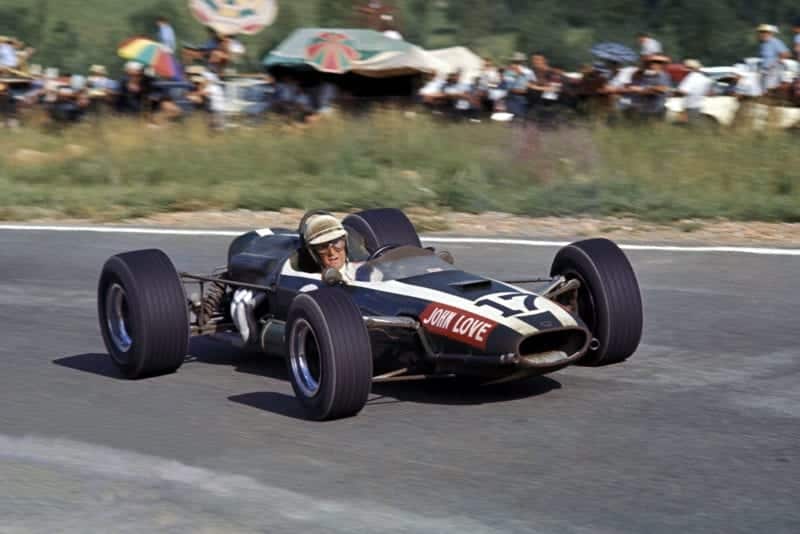
Local hero Love was leading with just six laps left until disaster struck
Motorsport Images
Courage retired the Parnell-Lotus BRM when he had a fuel line pulled off after an excursion on to the grass. The leader still seemed in control. Tingle retired when he lost the right wheel due to hitting a bank. The huge crowd (said to be the largest number of spectators ever gathered in the whole of the African Continent) were just beginning to think all was over bar the shouting when Hulme came into the pits at full speed, made some erratic locked-wheel slide, shouted at the mechanics and was off again.
All was action, mechanics opened a can of brake fluid, marshals cleared the road and one and a half minutes later, the leader was in. Off came the nosepiece, in went the fluid, dry ice was packed round the fuel pump, then, as the nose was being replaced, the crowd leapt to its feet and John Love went into the lead, then Rodriguez and Surtees went by. Hulme left the pits in fourth place, two laps down. He came in again for a brief moment, and on his way out nearly collected a worried tyre expert who was having a too-close look at his worn tyres.
“When only six laps from the end the very popular Love came in for only two gallons of fuel, the groan could be heard all round the track”
All was set now for a home win. Love’s engine was misfiring as he passed the pits but it had been doing this for most of the race. Unfortunately, the misfire had been causing increased fuel consumption and when only six laps from the end the very popular Rhodesian came in for only two gallons of fuel the groan could be heard all round the track. Rodriguez went by into first place and Love came out of the pits into second place before Surtees went by. Roy Salvadori slowed Rodriguez right down and the order remained to the end. Two Coopers were first and second, and the only two cars on the same lap, the winner, a 1966 car with the latest V12 Maserati engine, while second was an old Cooper with an old Climax 4-cylinder 2.7-litre engine.
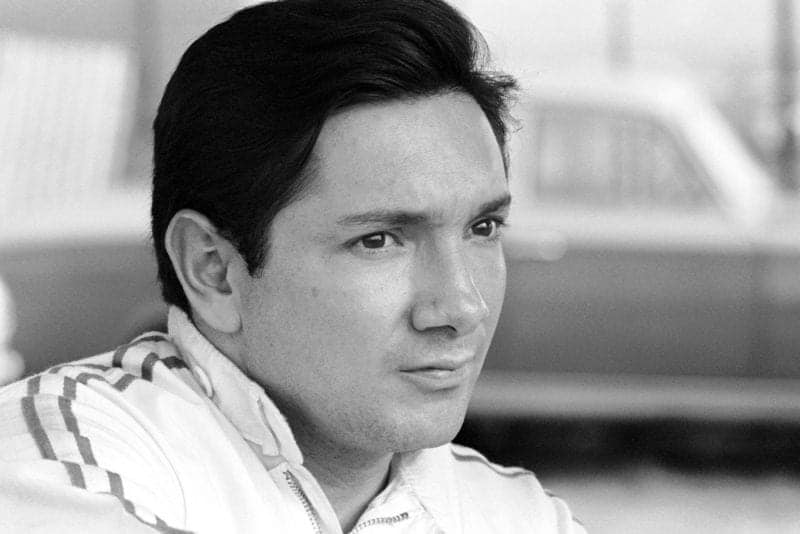
Rodriguez’s win made it a 1-2 for Cooper cars
Motorsport Images
When the winner stopped, his tyres were completely bald, while Surtees limped in after the slowing-down lap with only about eight pounds of pressure in the bald left rear wheel while the right-hand tubeless tyre was bald and completely flat. The surface, which was only paper thick, had given way to a stone which was on the track. Hulme came in fourth, a very disappointed man, while Anderson, who at the beginning had been almost last, came fifth. Jack Brabham was the last to qualify. The only other two still running, Charlton and Botha, had not completed the required number of laps.
The organisation and atmosphere made this an enjoyable well-run race.
